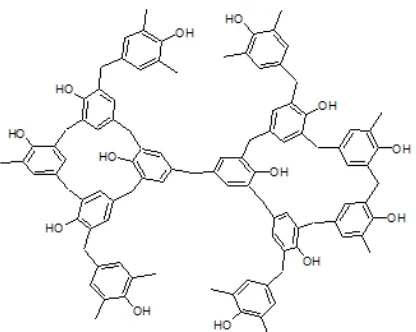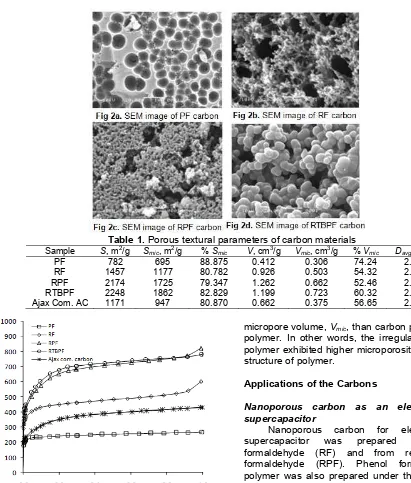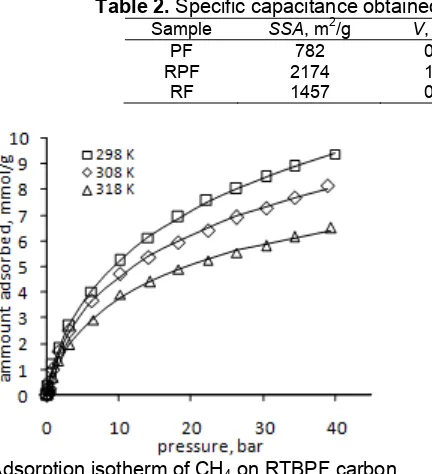Imam Prasetyo et al.
* Corresponding author. Tel/Fax : +62-274-902171/6492170 Email address : [email protected]
SIMPLE METHOD TO PRODUCE NANOPOROUS CARBON FOR VARIOUS APPLICATIONS
BY PYROLYSIS OF SPECIALLY SYNTHESIZED PHENOLIC RESIN
Imam Prasetyo1,*, Rochmadi, Teguh Ariyanto, and Rakhmat Yunanto
Chemical Engineering Department, Universitas Gadjah Mada, Jl. Grafika, No. 2, Yogyakarta 55281, Indonesia
Received January 18, 2013; Accepted June 22, 2013
ABSTRACT
Nanoporous carbon materials, a unique and useful material, have been widely used in many technologies such as separation processes, catalysis, energy storage, gas storage, energy conversion, etc. due to its high specific surface area and tunable porosity. In this research, nanoporous carbons were prepared using simple and innovative approach based on structural array of phenolic resin polymer without activation during carbonization process. The effect of phenolic reactant type and composition on pore structure and carbon surface morphologies was studied. Nanoporous carbon derived from resorcinol formaldehyde (RF) and from resorcinol phenol formaldehyde (RPF) polymers was suitable for electrode material supercapacitor and CO2 capture medium. RF-derived and RPF-derived
carbons provide electrode material supercapacitor with specific capacitance up to 246 F/g, whereas carbonized RPF exhibited CO2 uptake of 10.63 mmol/g (at 3.5 MPa 298 K). Nanoporous carbon derived from resorcinol
para-tert-butyl phenol formaldehyde (RTBPF) polymer exhibited attractive characteristics as methane storage media with methane uptake capacity as high as 8.98 mmol/g (at 3.5 MPa 298 K).
Keywords: porous carbon; phenolic formaldehyde polymer; supercapacitor; gas storage
ABSTRAK
Material karbon nanopori, sebuah material yang unik dan berguna, telah digunakan secara luas di berbagai bidang teknologi seperti proses pemisahan, katalis, penyimpan energi, penyimpan gas, dan konversi energi dikarenakan luas permukaan spesifik yang tinggi dan porositas yang mudah diatur. Pada penelitian ini, karbon berpori dibuat dengan cara yang mudah dan inovatif berdasar pada struktur polimer dari fenolik resin tanpa adanya proses aktivasi pada proses karbonisasi. Pengaruh tipe reaktan fenolik (fenol, resorsinol, para-tersierbutilfenol) dan komposisinya terhadap struktur pori dan morphologi permukaan karbon telah dipelajari pada penelitian ini. Karbon berpori yang diperoleh dari karbonisasi polimer resorsinol formaldehid (RF) dan resorsinol fenol formaldehid (RPF) sesuai untuk digunakan sebagai material elektroda superkapasitor dan media penjerap CO2. Karbon RF dan karbon
RPF memiliki nilai spesifik kapasitansi superkapasitor mencapai 246 F/g sedangkan karbon RPF menunjukan nilai penjerapan CO2 sebesar 10,63 mmol/g (3,5 MPa, 298 K). Karbon berpori yang diperoleh dari karbonisasi polimer
resorsinol para-tert-butilfenol formaldehid (RTBPF) menunjukkan karakteristik yang sangat sesuai sebagai media penyimpan gas metan dengan kapasitas penyimpanan sebesar 8,98 mmol/g (3,5 MPa, 298 K).
Kata Kunci: karbon berpori; polimer fenolik formaldehid; superkapasitor; penyimpan gas
INTRODUCTION
Nanoporous carbons have been widely used in many technologies such as separation processes, catalysis, energy storage, gas storage, energy conversion, etc. [1-3]. Preparations of nanoporous carbon with different methods and precursors have been performed by various research groups to search for material which is suitable for particular purpose [4-6]. Nanoporous carbon can be made by controlled pyrolysis of various natural carbonaceous matters such as coal, nut shell, cornstalks, wood, bamboo [8-10] or synthetic
polymer such as phenol formaldehyde, polyaniline, and melamine formaldehyde [11-13]. Compared to the natural precursor, the structure and purity of synthetic polymer could be controlled easily.
Imam Prasetyo et al.
there has not been a systematic effort to relate the structural properties and the morphologies of the carbonized polymers to the type and the composition of the reactant used in the polymerization processes. In our present study, nanoporous carbons were prepared by pyrolysis of specially synthesized phenolic formaldehyde polymer without any additional activation processes. In this approach, various phenolic compounds and composition of reactant were employed to obtain nanoporous carbon with specific properties which is suitable for application of electrode material supercapacitor, methane storage medium, and CO2 capture medium.
EXPERIMENTAL SECTION
Materials
The materials used in polymer preparation were phenolic compounds (phenol (P), resorcinol (R), and
para-tert-butyl-phenol (TBP)), and formaldehyde (F). Hydrochloric acid was used as catalyst in the polymerization reaction. Nitrogen gas with purity of 99.95% was supplied as a carrier gas during carbonization processes whereas ultra-high purity of compressed nitrogen (99.9995%) and liquid nitrogen were employed as the adsorbate in the measurement of BET surface area and as the coolant, respectively. The materials used in the preparation of supercapacitor electrodes were the resulted carbon as active material, carbon black as conductor, and polyvinyl alcohol (PVA) as binder while KOH 30% is used as an electrolyte solution in the supercapacitor testing. Furthermore, CH4 and CO2 high purity gases are used in the porous carbon applications as methane storage medium and CO2 capture material.
Instrumentation
The instrumentations used in this research were JSM-6360LA (JEOL) analytical scanning electron microscope and NOVA 2000 gas sorption and porosity analyzer.
Procedure
Precursors and nanoporous carbons preparation
Polymeric precursors were prepared through polycondensation reaction of phenolic compound with formaldehyde, under acidic condition. Phenolic compounds used in this experiment were phenol (P), resorcinol (R), and para-tert-butyl-phenol (TBP). Four different polymeric precursors prepared in this experiment were: phenol formaldehyde (PF), resorcinol formaldehyde (RF), resorcinol phenol formaldehyde
(RPF), and resorcinol para-tert-butyl-phenol formaldehyde (RTBPF).
Carbonization of the polymeric precursor was carried out in a furnace under flowing nitrogen (100 mL/min) from room temperature up to 1023 K at a heating rate of 3 K/min and kept at 1023 K for 2 h. Then the furnace was allowed to cool down to room temperature under nitrogen flow and the obtained carbon sample was washed with distilled water. Finally, the sample was dried at 383 K.
Structure and physical properties of nanoporous carbon
The surface morphologies of porous carbon materials were observed by JSM-6360LA (JEOL) analytical scanning electron microscope, and pore structure was measured with a NOVA 2000.
Porous carbon application
The specific capacitance of supercapacitor was measured by two-electrode system in a galvanostatic mode using 30% KOH as an electrolyte and a piece of polypropylene membrane as a separator. The positive and negative carbon electrodes were prepared by addition 80 wt% of porous carbon powders and 10 wt% of CB in 10 wt% of PVA dispersed in ethanol 70% to yield a homogeneous paste. The paste obtained was then rolled into 1 cm2 size Cu collector with a thickness of ±0.20 mm. The weight of the porous carbon powder (active material) was around 5–10 mg. The CO2 and CH4 adsorption capacity test of the porous carbons were carried out in an ultrahigh vacuum rig using volumetric method at desired temperatures and in the pressure range of 0-4 MPa. The adsorption measurement apparatus was constructed by Swagelok VCR® fittings.
RESULT AND DISCUSSION
In this research, nanoporous carbons for application of electrode material supercapacitor, methane storage medium, and CO2 capture medium were prepared by using simple and innovative approach based on structural array of phenolic resin polymer without activation during carbonization process. The effect of reactant type and composition used in the polymerization processes on properties and the morphologies of the carbonized polymers was studied.
Morphology of the Carbons
Imam Prasetyo et al.
Fig 1a. Representative structure of PF polymer Fig 1b. Representative structure of RF polymer
Fig 1c. Representative structure of RPF polymer Fig 1d. Representative structure of RTBPF polymer
react with formaldehyde in a similar mechanism, but the presence of –OH functional group in resorcinol and butyl functional group in para-tert-butyl phenol will direct the formation of polymer structures differently. Formaldehyde reacts with phenol at random ortho and
para directions (position 2, 4 and 6) to produce irregular network structure [17] while due to steric effect caused by the presence of –OH functional group in meta -position of the phenol ring, formaldehyde reacts with resorcinol more in positions 4 and 6 to produce more a linear network structure. In the case of para-tert-butyl phenol, formaldehyde reacts with its phenolic compound only at the two ortho-positions to produce a linear network structure. Hence the order of linearity of the network structure is RTBPF, RF, RPF, and PF resin. The surface morphologies of the carbons obtained from pyrolysis of those polymers (PF, RF, RPF, and RTBPF) were observed using SEM and presented in Fig. 2a, 2b, 2c, and 2d, respectively. It appears that difference carbon precursor produces different surface morphology. The more linear structure of polymeric resin, the more cavities is observed. Thus, it is obvious that the different in carbon surface morphology could be attributed to the nature of the polymeric precursor.
Pore Structure of the Carbons
The micropore structure of the carbon was analyzed by N2 adsorption/desorption BET measurement. The N2 adsorption isotherm of the carbons is presented in Fig. 3. Ajax® commercial activated carbon is presented for comparison with the prepared carbons. According to the IUPAC classification, the entire isotherm of the samples is type I characteristics which means that they have dominantly micropore structure with pore diameter less than 2 nm. Besides, Fig. 3 shows that the difference type of precursor will affect the adsorption isotherm of the product. It is shown that increasing adsorption isotherm at P/Po ~ 1 which is related with the presence of mesopore structure (pore diameter between 2-50 nm) is occurred in the resulted carbon when resorcinol is employed as a reactant.
Imam Prasetyo et al.
Table 1. Porous textural parameters of carbon materials
Sample S, m2/g Smic, m2/g % Smic V, cm3/g Vmic, cm3/g % Vmic Davg, nm
PF 782 695 88.875 0.412 0.306 74.24 2.11
RF 1457 1177 80.782 0.926 0.503 54.32 2.54
RPF 2174 1725 79.347 1.262 0.662 52.46 2.32
RTBPF 2248 1862 82.829 1.199 0.723 60.32 2.13
Ajax Com. AC 1171 947 80.870 0.662 0.375 56.65 2.26
Fig 3. N2 adsorption of porous carbon derived from
various polymers
substitute phenol added determine the micropore structure of the carbon. These values are comparable with or even higher than other researches using synthetic polymer as precursor using activation processes (chemical or physical activations) [1,13-14]. In line with N2-adsorption isotherm, it seems that the carbon produced from polymeric precursor in the presence of resorcinol has lower both of the percentage of micropore surface area, Smic, and the percentage of
micropore volume, Vmic, than carbon produced from PF polymer. In other words, the irregular structure of PF polymer exhibited higher microporosity than the regular structure of polymer.
Applications of the Carbons
Nanoporous carbon as an electrode material supercapacitor
Nanoporous carbon for electrode material supercapacitor was prepared from resorcinol formaldehyde (RF) and from resorcinol phenol formaldehyde (RPF). Phenol formaldehyde (PF) polymer was also prepared under the same condition for comparison with the investigated precursors. The choice of those of three carbons is appropriate since they represent a wide pore structure such as the surface area and the pore volume. Therefore, they are suitable for studying of the effect of the pore structure on the supercapacitor application. The specific capacitance of the porous carbon material electrode was be measured by simple test with constant current charge-discharge method. Capacitance (C) value is defined as the ratio of charge (q) to applied voltage (E) or it is presented by the following equation:
dq C
dE
Imam Prasetyo et al.
Table 2. Specific capacitance obtained from constant current-discharge method
Sample SSA, m2/g V, cm3/g Vmic, cm
Fig 4. Adsorption isotherm of CH4 on RTBPF carbon Fig 5. Adsorption isotherm of CO2 on RPF carbon
Table 3. Toth parameters and heat of adsorption of CH4 on
RTBPF carbon
The specific capacitance of the porous carbon material as calculated from those equations is listed in Table 2. The data shows that nanoporous carbon derived from pyrolysis of RF and RPF polymers provide attractive electrode material supercapacitor [1] with specific capacitance of 229 and 246 F/g, respectively. The specific capacitance increases with increasing the surface area of porous carbon as active surface of electrode. Furthermore RF and RPF carbons has high portion of mesopore,
VVmic
/V which lead ions transport in the pore quickly and increase the efficiency of surface area.Nanoporous carbon as CH4 storage medium
Nanoporous carbon for methane storage medium was derived from pyrolysis of RTBPF polymer. The RTBPF carbon has the high surface area and high microporosity which its characterizations are suitable for methane adsorption [18]. It is well known that the higher surface area leads to the higher adsorption capacity. The equilibrium adsorption of methane on the porous carbon was measured at three different temperatures (298, 308, and 318 K). The adsorption isotherms in the pressure range of 0-40 bar are shown in Fig. 4.
These isotherm data were well fitted by the Toth equation:
The parameter of Cμ is the adsorption capacity while the parameter of b and t are the adsorption affinity and adsorption system heterogeneity, respectively. The optimal parameter Cμ, b, and t for the methane are presented in Table 3. It is clear that the higher the temperature the lower the maximum adsorption capacity. It seems that the system heterogeneity increases with increasing the adsorption temperature since value of t is deviated further away from unity with decreasing temperature. The heat of adsorption at zero loading,H as calculated from Clapeyron equation is also included in the table.
It can be seen in Fig. 4 that nanoporous carbon derived from resorcinol para-tert-butyl phenol formaldehyde (RTBPF) polymer exhibited attractive characteristics as methane storage media with methane uptake capacity as high as 8.98 mmol/g (at 3.5 MPa and 298 K).
Nanoporous carbon as CO2 capture material
Imam Prasetyo et al.
Table 4. Toth parameters and heat of adsorption of CO2
on RPF carbon
The adsorption isotherms in the pressure range of 0-40 bar are shown in Fig. 5. The Toth parameters of CO2 on RPF-derived carbon are listed in Table 4. According to the parameters, the adsorption capacity,
Cμs, decreases with increasing adsorption temperature
while the system heterogeneity, t, increases with increasing the adsorption temperature. Fig. 5 shows that carbonized RPF exhibited competitive CO2 uptake of 10.63 mmol/g (at 3.5 MPa and 298 K).
CONCLUSION
Preparing nanoporous carbon for various applications by pyrolysis of specially synthesized phenolic resin has been examined. In this method, nanoporous carbons were prepared using simple and innovative approach based on structural array of phenolic resin polymer without activation during carbonization process. In the preparation of the phenolic formaldehyde polymer, various phenolic compounds, such as: phenol, resorcinol, and para-tert-butyl phenol, were used in order to obtain polymer material which is suitable for preparation of various nanoporous carbons. This new, simple and innovative approach yielded porous carbon which is suitable for application of electrode material supercapacitor, methane storage medium, and CO2 capture medium.
REFERENCES
1. Zhu, Y., Hu, H., Li, W., and Zhang, X., 2007,
Carbon, 45, 1, 160–165.
2. Meisner, G.P., and Hu, Q., 2009, Nanotechnology,
20, 204023.
3. Viswanathan, B., Indra Neel, P., and Varadarajan, T.K., 2009, Methods of Activation and Specific
Applications of Carbon Materials, National Centre for Catalysis Research, India.
4. Zhang, T., Walawender, W.P., and Fan, L.T., 2005,
Sep. Purif. Technol., 44, 247–249.
5. Prasetyo, I., Rochmadi, Yunanto, R., Ariyanto, T., and Wiratni, 2010, Proceedings of 17th Regional
Symposium on Chemical Engineering (RSCE),
Thailand.
6. Liu, C.L., Dong, W., Cao, G., Song, J., Liu, L., and Yang, Y., 2008, J. Electrochem. Soc., 155, 1, F1– F7.
7. Maciá-Agulló, J.A., Moore B.C., Cazorla-Amoróz, D., and Linares-Solano, A., 2004, Carbon, 42, 7, 1367–1370.
8. Tangjuank, S., Insuk, N., Tontrakoon, J., and Udeye, V., 2009, World Academy of Science, Engineering and Technology, 52, 110–116.
9. Zhang, F., Hua, M., Chen, J., Li, G-D, Zhang, Y., and Chen, J-S., 2008, Bioresour. Technol., 99, 11, 4803–4808.
10. Wei, S., Li, Z., and Yaping, Z., 2006, Chin. J. Chem. Eng., 14, 2, 266–269.
11. Kobayashi, N., and Kijima, M., 2007, J. Mater. Chem., 17, 4289–4296.
12. Ariyanto, T., Prasetyo, I., and Rochmadi, 2012,
Reaktor, 14, 25–32.
13. Hulicova, D., Yamashita, J., Soneda, Y., Hatori, H., and Kodama, M., 2004, Chem. Mater., 17, 5, 1241–1247.
14. Lenghaus, K., Qiao, G.G., Solomon, D. H., Gomez, C., Rodriguez-Reinoso, F., and Sepulveda-Escribano, A., 2002, Carbon, 40, 5, 743–749. 15. Cai, Q., Huang, Z-H., Kang F., and Yang J-B.,
2004, Carbon, 42, 4, 775–783.
16. Solar, C., Sardella, F., Deiana, C., Logo, R.M., Vallone, A., and Sapag, K., 2008, Mater. Res., 11, 4, 409–414.
17. Kumar, A., and Gupta, R.K., 1998, Fundamentals of Polymers, McGraw-Hill Book Co., Singapore, 96–98.



